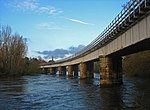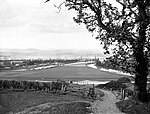Barnhill railway station, Perth
1847 establishments in Scotland1849 disestablishments in ScotlandDisused railway stations in Perth and KinrossPages with no open date in Infobox stationPerth and Kinross railway station stubs ... and 4 more
Railway stations in Great Britain closed in 1849Railway stations in Great Britain opened in 1847Railway stations in Perth, ScotlandUse British English from October 2019

Barnhill railway station served the suburb of Barnhill, Perth and Kinross, Scotland, from 1847 to 1849 by the Dundee and Perth Railway.
Excerpt from the Wikipedia article Barnhill railway station, Perth (License: CC BY-SA 3.0, Authors, Images).Barnhill railway station, Perth
Island View, Perth Barnhill
Geographical coordinates (GPS) Address External links Nearby Places Show on map
Geographical coordinates (GPS)
| Latitude | Longitude |
|---|---|
| N 56.388 ° | E -3.4213 ° |
Address
Barnhill
Island View
PH2 7HS Perth, Barnhill
Scotland, United Kingdom
Open on Google Maps










